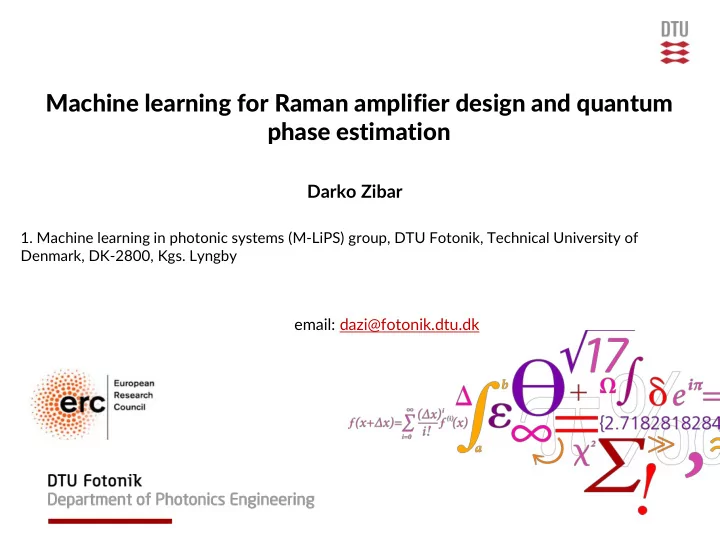

Machine learning for Raman amplifier design and quantum phase estimation Darko Zibar 1. Machine learning in photonic systems (M-LiPS) group, DTU Fotonik, Technical University of Denmark, DK-2800, Kgs. Lyngby email: dazi@fotonik.dtu.dk
Acknowledgements -Francesco Da Ros -Simone Gaiarin -Hou-Man Chin -Molly Piels, Juniper -Tobias Gehring, DTU Physics -Nitin Jain, DTU Physics -Ulrik L. Andersen, DTU Physics -Andrea Carena, Polotecnico Di Torino -Bernhard Schmauss, University of Erlangen-Nurnberg -Rasmus Jones -Julio Diniz -Martin Djurhuss -Jakob Thrane -Jesper Wass -Nicola De Renzis -Giovanni Brajato 2 DTU Fotonik, Technical University of Denmark 08/12/2018
Research topics • Nonlinear Fourier Transform techniques for optical communication • Noise characterization of lasers and frequency combs, (Menlo systems, UCSB, NBI) • End-to-end machine learning • Machine learning for optical fibre sensing (collaboration with Friedrich Alexander University of Erlangen-Nurnberg) • Quantum phase estimation (collaboration with DTU Physics) • Receiver design for quantum communication (collaboration with DTU Physics) The focus of the group is on the application of machine learning techniques to optical communication, quantum communication and optical sensing 3 DTU Fotonik, Technical University of Denmark 08/12/2018
Outline Machine learning in physical sciences • Inverse system learning • Inverse system learning for Raman amplifier design • Optical phase tracking framework for frequency combs • Quantum phase estimation • Conclusion and outlook • 4 DTU Fotonik, Technical University of Denmark 08/12/2018
Machine learning in physical sciences 5 DTU Fotonik, Technical University of Denmark 08/12/2018
Machine learning in physical sciences 6 DTU Fotonik, Technical University of Denmark 08/12/2018
Machine learning in optical communication • Optical performance monitoring • Quantum communication • Amplifier design • Laser noise characterization • Impairment compensation • End-to-end learning • Network optimization D. Zibar et al Nature Photonics, (11) 749-751, 2017 • Network failure detection 7 DTU Fotonik, Technical University of Denmark 08/12/2018
Supervised learning: deep neural networks output input Neural network learns the input-output mapping, ,using training data and perform prediction for new input data: 8 DTU Fotonik, Technical University of Denmark 08/12/2018
Deep learning for inverse system modelling Unknown -Problem if the mapping function is not bijective Learning the inverse mapping using deep neural networks 9 DTU Fotonik, Technical University of Denmark 08/12/2018
Raman amplifier for optical communication Incoming signal Raman pumps (wavelength, powers) Employing O, E, S and L band requires rethinking optical amplification 10 DTU Fotonik, Technical University of Denmark 08/12/2018
State-of-the-art: Raman amplifier optimization Repeat N times Raman solver Parameter optimization - High complexity due to Raman solver - Long convergence time - Restart optimization for new gain profile - Rely on genetic algorithms Objective: given a Raman gain profile determine pump powers and wavelengths 11 DTU Fotonik, Technical University of Denmark 08/12/2018 [1] B. Neto, OpEx 2007, [2] X. Liu, OpEx 2004, [3] P. Xia, PTL 2003
Raman amplifier design using machine learning 12 DTU Fotonik, Technical University of Denmark 08/12/2018 Zibar et al, submitted to OFC 2019 ( arXiv:1811.10381v1)
Simulation set-up and results In a multi-span system with hybrid EDFA Raman amplification, we consider: a single-span counter-propagation multi-pumps signals propagating in C-band (4 THz, 191-195 THz →1538.5 -1570.7 nm) SMF fiber 13 DTU Fotonik, Technical University of Denmark 08/12/2018
Results (a) Gain versus frequency (b) Error for different input powers The learned model works for any gain profile and the re-training is not required 14 DTU Fotonik, Technical University of Denmark 08/12/2018
Phase noise estimation for quantum communication Kleis and Schaeffer, Optics Letters 2018 Homodyne receiver: Phase diversity homodyne receiver: Received signal: Pilot tones have low power Average num. of photons/symbol Gaussian modulation Ultra-sensitive (optimal) detection of optical phase needed at the shot noise limit 15 DTU Fotonik, Technical University of Denmark 08/12/2018
Phase estimation for quantum sensing P Courtesy of Prof. Achim Peters https://www.physics.hu-berlin.de/en/qom/research/sensor Ultra-sensitive (optimal) detection fixed phase shift 16 DTU Fotonik, Technical University of Denmark 08/12/2018
Quantum phase estimation • System limited by quantum noise only (shot-noise limited system) • Due to Heisenberg uncertainty, optical phase not a single numerical value • Number of photons N p instead of SNR: Laser linewidth • SNR for shot-noise limited system: Receiver bandwidth • Phasor diagram of light in coherent state: Im Vacum fluctuations (noise): N p Re Is this model valid for N p 1? Can we detect optical phase if SNR<1? 17 DTU Fotonik, Technical University of Denmark 08/12/2018
State-of-the-art: evaluation of the accuracy • Variance is employed for accuracy estimation (tricky in the experiements) • Laser phase noise artificially induced as Wiener process (highly problematic) • Receiver bandwidth and linewidth equal: • Same laser used as transmitter and LO • SNR is high as the linewidth is chosen to be relatively small • For homodyne detection quantum noise limited variance: [1] Yonezawa, Science 2011 18 DTU Fotonik, Technical University of Denmark 08/12/2018
Conclusion and outlook • Optical phase tracking has applications in various fields • General Bayesian framework for ultra-sensitive phase detection presented • Phase evolution model learned from data • Tracking of mean phase and also covariance matrix demonstrated • Quantum limited performance achieved • Significant improvement to standard frequency noise measurements 19 DTU Fotonik, Technical University of Denmark 08/12/2018
Recommend
More recommend